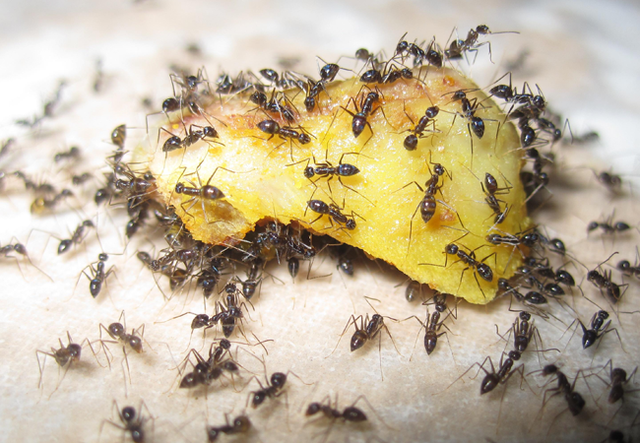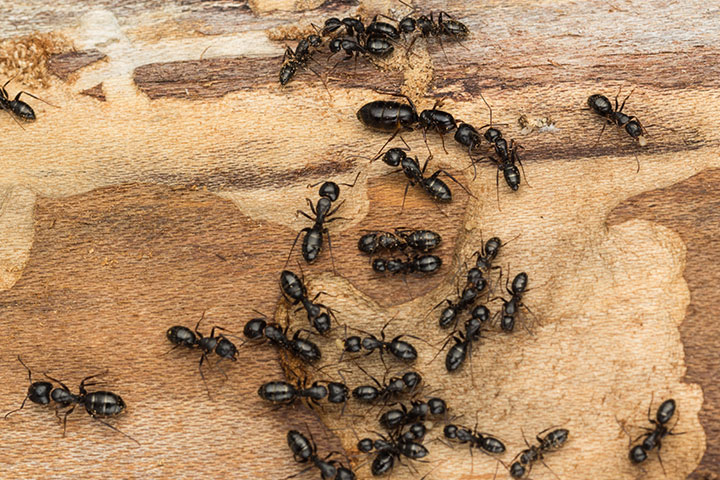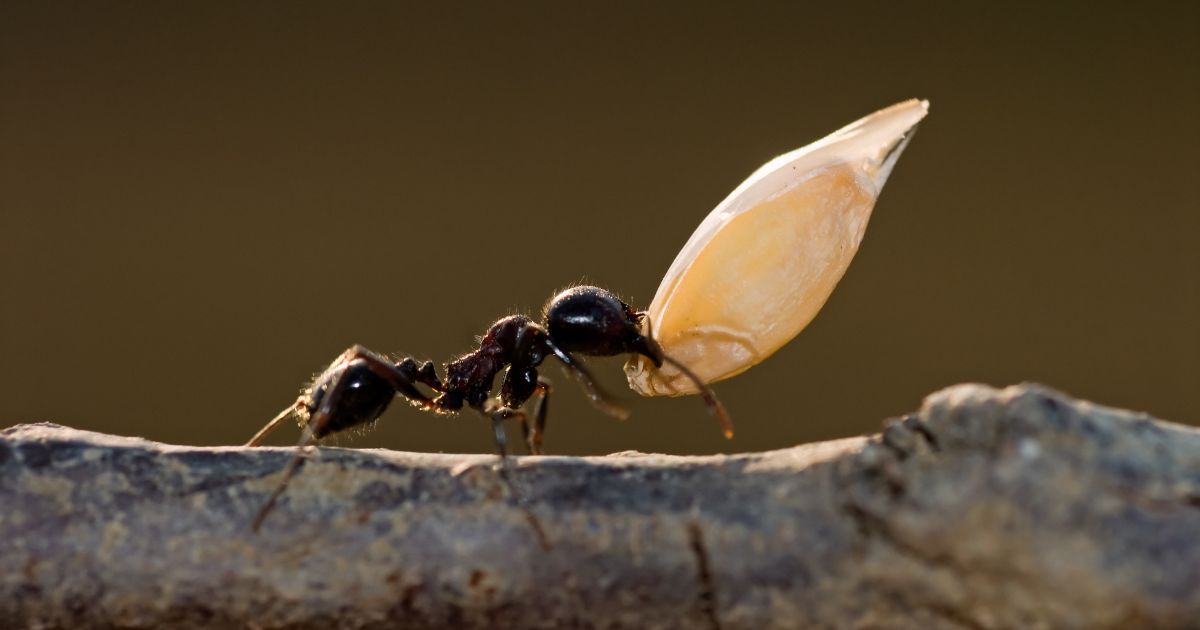Ants primarily eat sugars, proteins, and fats found in various food sources. Their diet includes nectar, seeds, fungi, or insects.
Ants exhibit remarkable versatility in their diet, adapting to consume whatever resources are available in their environment. These social insects work collectively, often relying on a division of labor to find and process their food. The foragers venture out and use their keen sense of smell to locate sustenance, ranging from sweet plant secretions to other small creatures or organic waste.
Understanding what ants eat is crucial for comprehending their ecological role and managing them as pests. Ants play a pivotal part in ecosystems as predators, herbivores, and decomposers, influencing both plant and animal populations. The study of ant dietary habits also offers insights into developing environmentally friendly pest control methods, ensuring a balance between human needs and biodiversity conservation.
Ant Diets Vary By Species
Welcome to the intriguing world of ant diets! Unlike humans, ants have varying dietary needs. Each species has its unique menu. Stick with us to explore what different ants munch on.
Variety Of Ant Species
Ant diversity is astonishing. With over 12,000 species, their diets can be just as diverse. Some love sweet nectar, others prefer proteins or fats. Let’s meet a few!
- Carpenter ants: Feast on proteins and sugary foods.
- Fire ants: Relish seeds, proteins, and greasy items.
- Leafcutter ants: Cultivate fungus as their primary food.
Typical Nutritional Needs
Nutrients are vital for ants, impacting their growth and colony health. A balanced diet usually includes:
| Nutrient Type | Function | Common Sources |
|---|---|---|
| Proteins | Muscle and larva growth | Insects, meats, eggs |
| Carbohydrates | Energy source | Nectar, fruits, honeydew |
| Fats | Energy reserves | Seeds, nuts, greasy foods |
Depending on the species, ants hunt, farm, or forage for their food. This versatility ensures their survival in diverse environments.
The Omnivorous Nature Of Ants
Did you know that ants are not picky eaters? Ants are omnivores. This means they eat both plants and animals. Their diet helps them survive in many environments.
Plant And Animal Foods
What do ants munch on? Their menu is vast! Ants enjoy:
- Seeds from plants for nutrients.
- Sweet nectar, which gives them energy.
- Small insects for protein.
- Dead animals help them grow.
| Food Type | Benefits to Ants |
|---|---|
| Seeds | Nutrients |
| Nectar | Energy |
| Insects | Protein |
| Carrion | Growth |
Ants have a special skill. They can adapt their eating habits. This special skill helps them live anywhere in the world.
Adaptive Feeding Habits
Ants change their diet based on what’s available. They are survivors! If there is no food, they will find something else to eat.
For example, if seeds are not around, they will hunt small insects. They work with what they have. This makes ants very successful creatures.
From Sugars To Proteins
Ants have a diverse diet ranging from the sweet nectar found in kitchens to the proteins they scavenge in nature. Understanding what ants eat helps control them in homes and appreciate their ecological role.
Craving For Carbohydrates
Ants love sweets. Their carbohydrate diet mainly includes:
- Fruits
- Nectar
- Sugary secretions from aphids (honeydew)
These energy-rich foods fuel their daily activities and are vital for their colonies’ growth.
Protein Pursuits
Proteins are crucial for ant growth and development. Common protein sources are:
| Protein Source | Examples |
|---|---|
| Insects | Dead or alive |
| Meats | Scraps, waste |
| Eggs | From various species |
Worker ants hunt and gather these proteins to feed their young and queen, ensuring the colony’s survival.

Credit: www.ecoguardpestmanagement.com
A Closer Look At Insect Consumption
Have you ever watched an ant and wondered, “What does it eat?” Insects make up a big part of an ant’s diet. This section dives into the fascinating world of ants and their appetite for insects. Join us as we explore the strategies they use to hunt and the advantages of including insects on their menu.
Hunting Strategies
Ants are masters of teamwork. They work together to overcome larger insects. Some ants use ‘ambush’ tactics, while others employ ‘group hunting’ methods to secure their prey. Even lone hunters exist among ants, using stealth to sneak up on unsuspecting insects.
- Ambush: Some ants hide and wait for the right moment to attack.
- Group Hunting: Many ants form large groups to take down bigger insects.
- Lone Hunters: Solitary ants rely on surprise and speed to catch their prey.
Dietary Benefits Of Insects
Insects are nutrient-rich food sources for ants. They provide proteins, fats, vitamins, and minerals. This helps ants grow, repair their bodies, and stay healthy. Insects also offer a diverse range of flavors, textures, and nutrients that suit different ant species.
| Nutrient | Benefit |
|---|---|
| Protein | Builds and repairs ant muscles |
| Fats | Energy source for long hunts |
| Vitamins & Minerals | Keeps ant colonies healthy |
From developing larvae to adult workers, every ant benefits from this diet. It ensures colony survival and success in the diverse environments ants inhabit.
Plant Materials In Ant Meals
Think of ants, and you might imagine tiny creatures scurrying for crumbs. But many ants are more like gardeners than scavengers. They thrive on a diet rich in plant materials. From seeds to grain and even fungus, a variety of ant species have evolved to harness the nutritional value of plants.
Seeds And Grains
Seeds and grains serve as a staple in the diets of some ants. These resourceful insects collect and store these plant bits for future use. Below is a snapshot of how ants interact with these plant materials:
- Harvester ants: They prioritize seed collection and have adapted to grind them for consumption.
- Gather and store: Ants stockpile seeds in their nests, ensuring a steady food supply.
- Seed dispersal: In their quest for food, ants play a vital role in spreading plant seeds, aiding in plant growth and ecosystem diversity.
Fungus Farming Ants
Meanwhile, fungus farming ants take plant consumption to the next level. They cultivate fungus within their colonies by feeding it plant matter, like leaves. This ingenious approach supports complex communities:
| Ant Species | Fungus Cultivation |
|---|---|
| Leaf-cutter ants | They cut leaves to nourish their fungal gardens. |
| Attine ants | Known as the original fungus farmers, they’ve been tending to their fungal crops for millions of years. |
Ants’ involvement in fungus farming showcases their role as ecological engineers, affecting plant and fungal distribution worldwide.
Decay And Detritus As Food Sources
Ants are not picky eaters, and decay and detritus offer a banquet for these tiny creatures. Imagine a forest floor with leaves and dead insects. To ants, that’s like an all-you-can-eat buffet! Now, let’s explore how ants make the most of dead matter and what role they play in keeping ecosystems clean.
Feasting On Dead Matter
Ants are crucial in the recycling of organic material. Fallen leaves, dead insects, and even animal carcasses do not linger long with ants around. They are quick to find and break down this material, which serves as their food. This process not only feeds the ants but also returns nutrients to the soil.
- Plant Matter: Ants break down leaf litter and plant pulp.
- Animal Remains: They consume carcasses down to the bone.
- Nutrient Cycling: Ant activity enriches the soil, promoting plant growth.
Role In Ecosystem Decomposition
Ants are like nature’s cleanup crew. They speed up decomposition, turning lifeless forms into valuable soil nutrients. This role is vital for healthy ecosystems. Without ants, the process of decomposition would slow down, leading to the accumulation of dead matter.
| Decomposition Element | Ants’ Impact |
|---|---|
| Soil Aeration | Ants tunneling improves soil health. |
| Waste Reduction | They minimize waste by consuming it. |
| Nutrient Distribution | Nutrients spread as ants disperse waste. |
Through their constant work, ants contribute to a balanced and thriving ecosystem. Their role in decomposition proves that even the smallest creatures can have a significant impact on our planet.
Liquid Nourishment For Ants
Think of ants, and you might picture them carrying crumbs or leaves. But did you know ants crave liquid nourishment too? Just like us, ants need a balanced diet. Liquids form a critical part of their nutrition. From the sap of plants to the sweet secretions of other insects, ants are connoisseurs of sugary fluids. Let’s dive into the world of liquid gold that keeps these tiny creatures bustling with energy.
Aphid Honeydew
Ants cherish a sweet liquid called aphid honeydew. This isn’t your typical honey. It’s a sugary secretion produced by aphids as they munch on plant sap. Ants are so fond of honeydew, they’ll do whatever it takes to get it, including protecting the aphids from predators! Imagine an army of ants guarding their own personal honey factory:
- Ants farm aphids like cows to harvest honeydew.
- They stroke aphids with their antennae to encourage honeydew production.
- Honeydew is rich in sugar but also contains vital proteins and amino acids.
Plant Nectar
Plant nectar is another favorite for ants. This sweet fluid is packed with energy and is often found in flowers. Ants are not as efficient pollinators as bees, but they still play a role. They collect nectar to feed their colony:
| Plant Part | Nectar Composition | Ant Benefit |
|---|---|---|
| Flowers | Sugars, amino acids, minerals | Energy, nutrition |
| Extrafloral Nectaries | Sugar-rich liquid | Attracts ants for protection against herbivores |
Ants play a surprising part in the plant world. Some plants have special structures called extrafloral nectaries. These are not found in flowers. They produce nectar to attract ants for the plant’s defense. Clever, right?

Credit: www.pestworldforkids.org
Human Impact On Ant Diets
The foods ants eat can change because of people. We leave lots of scraps. Ants find and eat these scraps. Today’s post dives into how humans influence what ants eat.
Ants In Urban Environments
Ants live all over cities. Buildings and streets replace plants and dirt. Yet, ants still thrive. They sneak into houses and sidewalks. They search for food where humans live and work.
- Ants find crumbs in kitchens
- Parks provide picnic leftovers
- Garbage bins are a feast for ants
Pavements and lawns host small ant colonies. These places offer shade, moisture, and food.
Adapting To Human Food Waste
Ants are survivors. They adapt to new food sources quickly. Our waste becomes their treat.
Sugary spills, chips, and bread attract ants. Wrappers and food containers in trash become ant buffets.
| Ants Love: | Found In: |
|---|---|
| Sweets | Soda cans, candy wrappers |
| Protein | Discarded meat, pet food |
| Fats | Oil spills, greasy packages |
Ants visit our homes more when they eat our food. This can cause trouble for us. But ants only want to survive.
Interesting, right? Our leftovers shape ant diets in ways we see every day. Next time you spot an ant line, remember – it’s a little piece of human-ant history!

Credit: www.healthline.com
Frequently Asked Questions For What Ant Eat
What Do Ants Typically Eat?
Ants are omnivores and their diet includes seeds, fungi, sweets, meats, and other insects. They are attracted to anything that can provide nourishment including sugary substances and proteins, adjusting their diet based on what’s available.
How Do Ants Find Their Food?
Ants find food using their keen sense of smell. When foraging, ants leave a pheromone trail back to their colony. Other ants follow this scent path directly to the food source, allowing the entire colony to benefit.
Can Ants Eat Human Food?
Yes, ants can eat human food, often targeting sweet, greasy, or meat-based leftovers. Their versatile diet means they can consume many things found in homes, making them common household pests.
Do Ants Eat Plants Or Meat?
Ants have a diverse diet that can include both plant matter, like seeds and nectar, and meat from insects or dead animals. Diet composition largely depends on the ant species and food availability.
Do Ants Eat a Variety of Foods, Including Larger Animals’ Brains?
Yes, it is a widely known fact that ants eating elephant brains is just a myth. Ants are primarily scavengers and feed on a variety of foods such as fungus, nectar, and small insects. While they may be small, they do not consume larger animals’ brains.
Conclusion
Understanding the dietary habits of ants reveals their role in ecosystems. They are diverse eaters, feasting mainly on sweets, proteins, and fats. Their adaptability in diet reflects their survival strategies. Encountering different food types, ants contribute significantly to ecological balance and nutrient cycling.
Remember, their food choices impact both their colonies and our environment.
{ “@context”: “https://schema.org”, “@type”: “FAQPage”, “mainEntity”: [ { “@type”: “Question”, “name”: “What do ants typically eat?”, “acceptedAnswer”: { “@type”: “Answer”, “text”: “Ants are omnivores and their diet includes seeds, fungi, sweets, meats, and other insects. They are attracted to anything that can provide nourishment including sugary substances and proteins, adjusting their diet based on what’s available.” } } , { “@type”: “Question”, “name”: “How do ants find their food?”, “acceptedAnswer”: { “@type”: “Answer”, “text”: “Ants find food using their keen sense of smell. When foraging, ants leave a pheromone trail back to their colony. Other ants follow this scent path directly to the food source, allowing the entire colony to benefit.” } } , { “@type”: “Question”, “name”: “Can ants eat human food?”, “acceptedAnswer”: { “@type”: “Answer”, “text”: “Yes, ants can eat human food, often targeting sweet, greasy, or meat-based leftovers. Their versatile diet means they can consume many things found in homes, making them common household pests.” } } , { “@type”: “Question”, “name”: “Do ants eat plants or meat?”, “acceptedAnswer”: { “@type”: “Answer”, “text”: “Ants have a diverse diet that can include both plant matter, like seeds and nectar, and meat from insects or dead animals. Diet composition largely depends on the ant species and food availability.” } } ] }

I’m MD Tanvir, and I bring years of expertise gained from working closely with pest control companies to the forefront. My journey in the industry has inspired me to launch Bug Battler, a platform aimed at equipping people with the know-how to combat pests autonomously. Through Bug Battler, I aim to empower individuals with practical insights to tackle pest infestations effectively.

